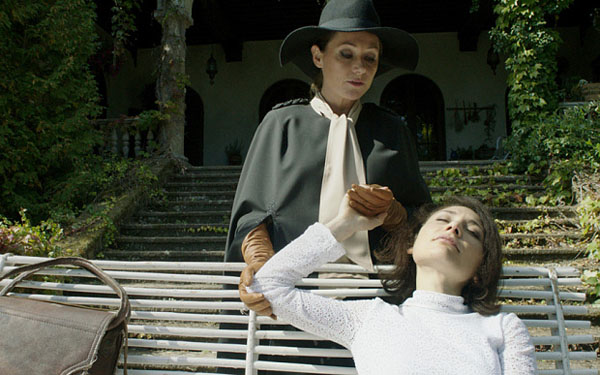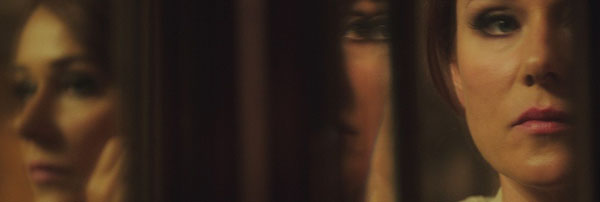Peter Strickland’s followup to Katalin Varga (2009) and Berberian Sound Studio (2012) has seen its world premiere in Toronto and it’s Noel Murray‘s “favorite movie of this year’s TIFF… (so far)… Where Berberian Sound Studio used Italian giallo thrillers as a way to explore the human mind’s ability to turn sounds and thoughts into threats, The Duke of Burgundy considers the complications of romantic relationships, via a deconstruction of 1970s softcore Eurotica. Sidse Babett Knudsen and Chiara D’Anna play Cynthia and Evelyn, variations on the classic kinky lesbian lovers from old French and British sexploitation films: the kind who dwell in an opulent mansion and spend their time binding and spanking each other behind ornate wooden doors. After playing out one of those typical Eurotica scenarios in its first 15 minutes, The Duke of Burgundy starts to show what happens to these two women when they’re not actively engaged in their sex-games. They get bored with their roles, they attend lectures on entomology, they meet with the local designer of torture devices, and the argue over whether they can take a night off from bondage and water-sports…. It’s one of the damnedest love stories I’ve ever seen on the big screen.”
“Perhaps the major discovery” of this year’s edition, agrees David Ehrlich at Little White Lies. “The gothically lovelorn score by the band Cat’s Eyes drapes the film in a dreamy veil of morbid romance, and Strickland’s frequent detours into associative insect imagery underscore the story with the dormant threat of metamorphosis (the metaphor is never explicit or on the nose, and that vagueness allows for an ominous sense of body horror that makes Evelyn’s anxieties urgent and real). Strickland even nods to Brakhage in a climactic sequence that provides this giddily repressed film with its only moment of howling release. The fact that the film doesn’t show so much as an errant nipple makes it all the more kinky, adding to the sensation that you’re getting too much pleasure from something that you shouldn’t even be watching. The Duke of Burgundy, the inexplicable title of which becomes a devilish tease for the imagination, is tender and mournful, but also smirkingly fun and seriously hot.”
It’s “hair-raisingly kinky stuff,” adds the Telegraph‘s Robbie Collin, “although only after a while do we realize the film itself is engaged in role-play with its audience, meeting certain expectations that it later tantalizingly subverts. Lines of dialogue that once meant one thing are suddenly charged with their opposite meaning…. Knudsen and D’Anna are both terrific, and have tremblingly palpable chemistry, although the film is so teasing and elusive that after one viewing, you just want to watch the thing again, and feel your way again around its contours.”
The AV Club‘s A.A. Dowd: “Burgundy turns out to be a much funnier and more humanistic picture than it initially appears, applying the tropes of its chosen genre—including some heavy fetish fuel—to a richer study of desire and relationships. While Berberian was dazzling but slightly empty, Burgundy is heavy with feeling.”
“More akin to the erotic atmosphere of Belle de Jour than the moody horrors of Jean Rollin, Burgundy is strangely beguiling and utterly intoxicating,” writes Nicholas Bell at Ioncinema. “The film is rich with some of the finest high threadcount production design since Park Chan-wook’s Stoker,” adds Jordan Hoffman in the Guardian. More from Leslie Felperin (Hollywood Reporter), Jared Mobarak (Film Stage) and Ben Nicholson (CineVue, 4/5).
Updates, 9/10: “Strickland had a whole sub-genre of arthouse erotica in mind when he conceived of Evelyn and Cynthia’s unconventional exploits, and it’s from this somewhat obscure creative well that he drew much of the film’s inspiration,” writes Calum Marsh, who talks with the director for the National Post. “One figure whose influence looms large is Jess Franco, the much-beloved cult director responsible for a string of disreputable horror films from the 1970s, many of which had a more than a shade of the pornographic. ‘I was fascinated by the stereotypes of Jess Franco’s cinema—female on female sexuality, sadomasochism,’ says Strickland. ‘But also he had this wonderful, fantastical sensibility. It often misfired, but when it did fire it just shot you down this portal that was unlike anything else.'”
More from Nikola Grozdanovic (Playlist, A) and Kurt Halfyard (Twitch).
Updates, 9/12: Strickland “dives into the fever-dreams of Radley Metzger and Walerian Borowczyk, not for facile pastiche re-creation but for a rigorous and opulent portrait of a sadomasochistic romance,” writes Fernando F. Croce in the Notebook. “Like Berberian, it’s a hermetic tale that builds toward a protagonist’s release/breakdown, with avant-garde bursts that threaten to tear apart the film’s elegant veneer.”
“A stray line about a ‘Dr. Viridiana’ early in The Duke of Burgundy gives the game away,” argues Adam Nayman in Cinema Scope. “Strickland is chasing Luis Buñuel. Not with too much urgency, mind you: on the basis of his three features to date, the British writer-director is less interested in precise pastiche than evoking the baseline sensations of movies gone by.” And “there’s something melancholy about Evelyn and Chiara’s rigorous, elaborate, and absurd bedroom gamesmanship, which finally seems an attempt to control the waxing and waning passions between committedly monogamous partners. Desire as an infernal loop—come to think of it, it’s very Belle de Jour.”
Burgundy “is the first film I’ve seen here this year by a director in complete artistic control,” writes Wesley Morris in a dispatch back to Grantland. “No one’s tried a film like this in a long, long time: an airless love story between women imagined by a man. Rainer Werner Fassbinder’s The Bitter Tears of Petra von Kant, from 1972, is the most obvious thing that comes to mind. But so does Victor Erice’s very different The Spirit of the Beehive from ’76, in which two little girls fall into an obsession with Frankenstein. The psychological complexity of Fassbinder’s cold, neurotic movie and the strange warmth and entomology of Erice’s are made formally complex with Strickland.”
Update, 9/20: A first clip via the Playlist:
Updates, 9/14: “Strickland proves to be as much a master of tremblingly sexy cinematic power-of-suggestion as Wong Kar-Wai was in In the Mood for Love,” writes Kenji Fujishima at In Review Online. “The most heartening thing about The Duke of Burgundy is in how seriously it takes this central romance, in the end. Though Strickland isn’t shy about milking its premise for maximum sexual heat, there’s no mockery towards Cynthia and Evelyn’s emotional movements.”
“Opening with a credits sequence of fonts and freeze frames that appear to be lifted from a ’70s film, it is immediately apparent that Strickland’s eye for detail is astounding,” writes David Acacia at the International Cinephile Society. “The film is ablaze with earrings and brooches and skirts which are stunning accessories and garments, in their own right, but it is how he shoots them that is truly compelling.”
Update, 10/18: “It’s one of the seductive strengths of The Duke of Burgundy that, for all its surface provocation, the movie’s central relationship emerges as a surprisingly tender romance between two people who each fear losing the other, even as they acknowledge that the initial spark of passion has grown fainter over time,” writes Variety‘s Scott Foundas. “That’s largely a credit to the performances of D’Anna and Knudsen, who play things straight (so to speak), and who communicate volumes about their characters through the subtlest variations on their endlessly repeated scene—a structure that gives the movie a glancing connection with Jacques Rivette’s classic Celine and Julie Go Boating. And while not all audiences may relate to this particular couple’s efforts at renewal (including, in perhaps the most memorable scene, a consultation with a custom fetish-bed carpenter), the underlying emotions are nevertheless universal.”
Update, 1/10: “To say that Peter Strickland traffics in Seventies Euro-schlock is to tell only half the story,” writes Steven Mears for Film Comment. “True, he’s better than anyone this side of Todd Haynes at conjuring the textures and tones of anterior subgenres, in Strickland’s case the pulp art imports of Jess Franco and Dario Argento. But underneath the veneer of exploitation is the last thing you’d expect—a portrait of midlife angst, a longing for stability and acceptance in a pitiless world.”
Update, 1/15: Nicolas Rapold for the L: “A was-it-all-just-a-dream conceit glimmers in the film’s bookends (Evelyn perched, like a moth on a log, by a forest stream), not to mention a few odd details (such as the mannequins planted in the audience of a lecture). ‘Try to have more conviction next time,’ Evelyn chides Cynthia after a session in bed, and it’s easy to accuse Strickland of hiding behind his obsessions, but even if he hasn’t re-discovered the sense of danger in his first feature, Katalin Varga, he’s crafted another wry story precisely about obsession.”
Update, 1/16: Graham Fuller interviews Strickland for Film Comment.
Update, 1/18: “Like many male directors telling a woman’s story,” writes Chuck Bowen for Slant, “Strickland is attempting to achieve empathy by a form of pronouncedly indulgent cleansing: He charges full-tilt into the objectifying whims of his fantasies in order to somehow reach the other end of perception, which acknowledges the ultimate empathetic limitations of said fantasies. Amazingly, Strickland, aided by two extraordinarily fluid and expressive performances, realizes this aim with little hypocrisy.”
Updates, 1/23: “What turns out to be most purposefully discomfiting about Strickland’s film, perhaps, is how indecently average its characters turn out to be,” writes Michael Koresky in Reverse Shot. “Kinky but never salacious, The Duke of Burgundy is a penetrating dissection of an imbalanced relationship before it shifts into being a surreal, teasingly nightmarish evocation of that imbalance, and it’s more fascinating as the former than the latter.”
More from Glenn Kenny (RogerEbert.com, 2.5/4), Jonathan Romney (Film Comment), A.O. Scott (NYT) and Scott Tobias (Dissolve, 4.5/5).
For the Playlist, Christopher Bell talks with Strickland about the films that have influenced The Duke of Burgundy. More interviews with Strickland: Ashley Clark (Reverse Shot), Clark Collis (EW), Stephen Saito, Sarah Salovaara (Filmmaker), Dan Schindel (Movie Mezzanine), Charlie Schmidlin (Playlist) and Christopher Schobert (Film Stage).
Update, 1/25: Danny Miller interviews Strickland for Cinephiled.
Updates, 2/23: Salon‘s Andrew O’Hehir suggests that “while Strickland’s films already aren’t like anyone else’s, his real secret is that even in this strange constructed world, his characters feel like real people struggling with issues that aren’t exotic at all. Like the repressed English sound engineer played by Toby Jones in Berberian Sound Studio, Evelyn and Cynthia are able to glimpse realms of ecstasy and freedom they can’t quite reach. They play out roles that are meant to be liberated and fulfilling and instead have become absurdly confining (not unlike the specially constructed box beneath Cynthia’s mattress, in which Evelyn yearns to be confined). That’s a situation that may perhaps seem familiar to many of us, whether or not we live in an isolated colony of all-female S/M lepidoperists.”
Carson Lund for In Review Online: “If the film’s finally more satisfying as a dexterous directorial exercise than a moving depiction of the fundamental give-and-take of committed relationships, it’s only because these two boldly cast actresses — great as they are at portraying transient desires and unstated friction in a vaguely May-December-ish romance — never really get to offer a convincing sense of how they may have (D’Anna with her nasally recitations suggesting a children’s librarian reading at story time and Knudsen in demure intellectual mode) sustained their relationship outside of the fetishistic escapades. Mileage will vary on this last point, but few should dispute at this stage that Strickland is a guy with vision.”
Toronto 2014 Index. For news and tips throughout the day every day, follow @KeyframeDaily. Get Keyframe Daily in your inbox by signing in at fandor.com/daily.





